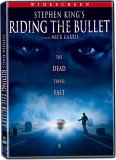Synopsis
Set for no very compelling reason in 1969, this story sees death-obsessed art student Jonathan Jackson walking and hitch-hiking his way along spooky Maine highway in the middle of the night, trying to make it a hundred miles to where his stroke-felled mother (Barbara Hershey) lies in a hospital. Jackson has such a vivid imagination that neither he nor the viewer really knows what, if anything, we see is real, particularly when he is picked up by a messenger of death (David Arquette), driving…a Plymouth Fury (Christine, anyone?). Arquette tells Jackson that either he or his mother will die tonight, and he must choose…
Of the many directors who have adapted King’s work for the screen, Mick Garris is one of the most faithful, and that is one of the problems with the film. Much of King’s dialogue and literary conceits work wonderfully in print, but when translated to a visual medium, the result is frequently hamfisted and overly literal. Such is the case here. Futhermore, David Arquette is quite simply very difficult to buy as a boogeyman. Jackson himself turns in fine work, however. The “is it real or is he imagining things?” technique works to keep viewers off-balance for the first half of the film, but by the end becomes irritating through overuse. A noble effort, then, but with only mixed results.
Audio
Very nice audio, which gives the film much more punch than it might really deserve. The music and BOO! cues are particularly big and effective. The environmental effects are solid, too, if not completely overwhelming. Still, all the spooky wind in surround that one could wish for.
Video
The picture is even nicer. The transfer is very sharp, and the colours are rich and extremely strong, with terrific contrasts and blacks, and the night scenes are moody without ever being murky. No grain or edge enhancement issues, either. This looks just great.
Special Features
Two commentary tracks, which is more than this film needs, really, but there you are. The more nuts-and-bolts of the two is the one with Garris, Jackson, DP Robert New, producer Joel T. Smith and two members of KNB FX. Garris’ solo commentary is quite engaging, and recounts in very interesting fashion the difficulties he had in getting the film made. There are seven very short featurettes, each lasting only a few minutes or less. They are: “David’s Makeup,” “Alan’s Artwork” (done by legendary horror artist Bernie Wrightson), “Picture Cars,” “A Cemetery Shoot,” “Fury Crash,” “Shooting at Thrill Village,” and “Storyboard Comparisons.” More of Wrightson’s art shows up in a slide-show gallery, and there’s athe trailer. Most of the menu is animated and scored, and has a cheerful nostalgic wackiness to it, even if its connection to the film is a bit tangential.
Closing Thoughts
As Stephen King adaptations go, this is workmanlike. But it makes one realized that all those years ago, Stanley Kubrick hit closer to the spirit of King’s work by violating the letter.
Special Features List
- Audio Commentaries
- 7 Featurettes
- Artwork Gallery
- Trailer






